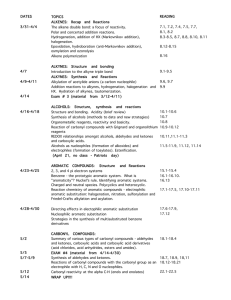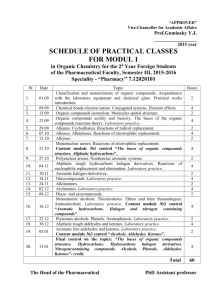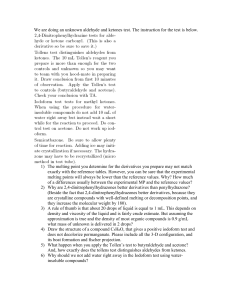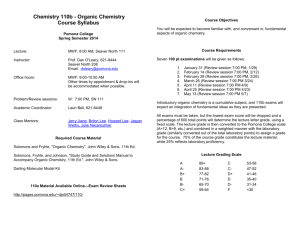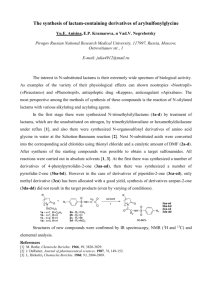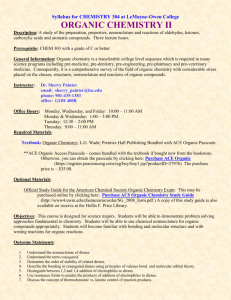Spring 2009
advertisement
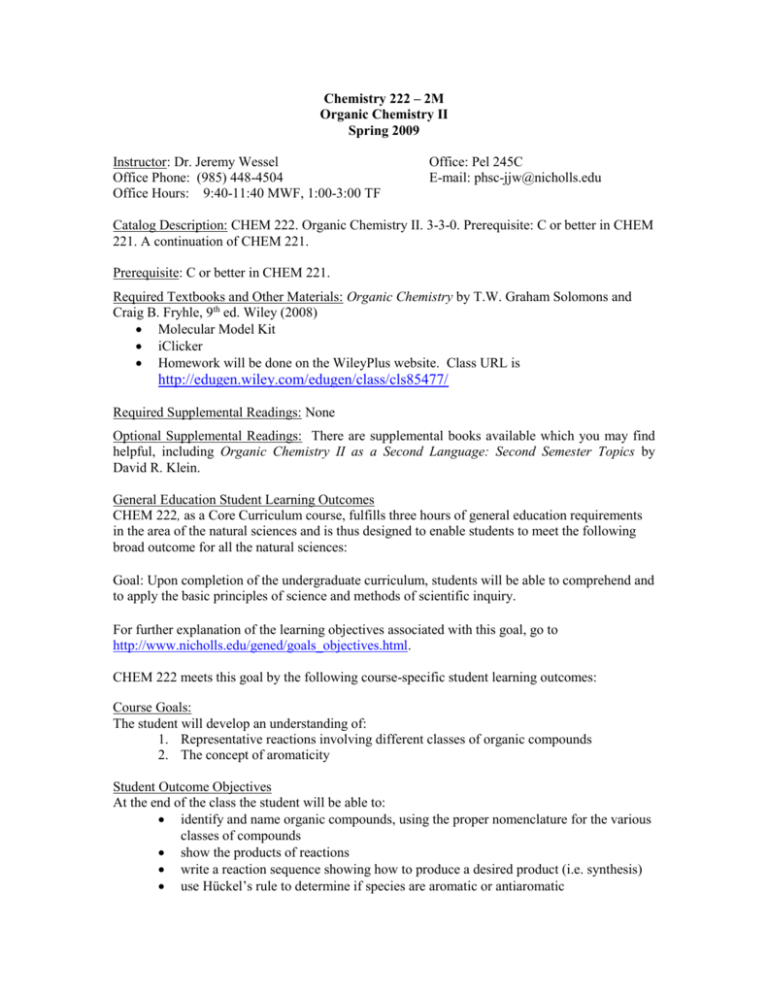
Chemistry 222 – 2M Organic Chemistry II Spring 2009 Instructor: Dr. Jeremy Wessel Office Phone: (985) 448-4504 Office Hours: 9:40-11:40 MWF, 1:00-3:00 TF Office: Pel 245C E-mail: phsc-jjw@nicholls.edu Catalog Description: CHEM 222. Organic Chemistry II. 3-3-0. Prerequisite: C or better in CHEM 221. A continuation of CHEM 221. Prerequisite: C or better in CHEM 221. Required Textbooks and Other Materials: Organic Chemistry by T.W. Graham Solomons and Craig B. Fryhle, 9th ed. Wiley (2008) Molecular Model Kit iClicker Homework will be done on the WileyPlus website. Class URL is http://edugen.wiley.com/edugen/class/cls85477/ Required Supplemental Readings: None Optional Supplemental Readings: There are supplemental books available which you may find helpful, including Organic Chemistry II as a Second Language: Second Semester Topics by David R. Klein. General Education Student Learning Outcomes CHEM 222, as a Core Curriculum course, fulfills three hours of general education requirements in the area of the natural sciences and is thus designed to enable students to meet the following broad outcome for all the natural sciences: Goal: Upon completion of the undergraduate curriculum, students will be able to comprehend and to apply the basic principles of science and methods of scientific inquiry. For further explanation of the learning objectives associated with this goal, go to http://www.nicholls.edu/gened/goals_objectives.html. CHEM 222 meets this goal by the following course-specific student learning outcomes: Course Goals: The student will develop an understanding of: 1. Representative reactions involving different classes of organic compounds 2. The concept of aromaticity Student Outcome Objectives At the end of the class the student will be able to: identify and name organic compounds, using the proper nomenclature for the various classes of compounds show the products of reactions write a reaction sequence showing how to produce a desired product (i.e. synthesis) use Hückel’s rule to determine if species are aromatic or antiaromatic demonstrate a knowledge of electrophilic aromatic substitution, including substituent effects demonstrate a knowledge of organometallic compounds and their uses in synthesis demonstrate a knowledge of nucleophilic addition to carbonyl compounds and epoxides demonstrate a knowledge of the oxidation of alcohols demonstrate a knowledge of oxidation and reduction of carbonyl compounds demonstrate a knowledge of enols and enolates and their reactions demonstrate an understanding of substituent effects on acidity and basicity demonstrate an understanding of nucleophilic acyl substitution including the relative reactivity of carboxylic acid derivatives demonstrate an understanding of the use of enolates for carbon-carbon bond formation demonstrate a knowledge of amines including methods of preparation and reactions Course Content: Chapter 11: Alcohols and Ethers Nomenclature of ethers and epoxides, conversion of alcohols to alkyl halides, sulfonate leaving groups, etherification of alcohols, Williamson ether synthesis, silyl ethers, acid-catalyzed cleavage of ethers, epoxidation, ring-opening of epoxides. Chapter 12: Alcohols From Carbonyl Compounds Oxidation-reduction reactions in organic chemistry, alcohols by reduction of carbonyl compounds, oxidation of alcohols, preparation of organolithium and Grignard compounds and their use in synthesis Chapter 13: Conjugated Unsaturated Systems Allylic radical substitution, electrophilic addition to conjugated dienes, Diels-Alder reaction, Chapter 14: Aromatic Compounds Nomenclature of benzene derivatives, structure and bonding in benzene, Hückel’s rule, aromaticity and antiaromaticity, aromatic ions, heterocyclic aromatic compounds Chapter 15: Reactions of Aromatic Compounds Mechanisms and products of electrophilic aromatic substitutions: halogenation, nitration, sulfonation, Friedel-Crafts; reduction of acylbenzenes; substituent effects on regioselectivity and rate, regioselective synthesis, reactions of aromatic side chains, Birch reduction. Chapter 16: Aldehydes and Ketones I: Nucleophilic Addition to the Carbonyl Group Nomenclature of aldehydes and ketones, preparation of aldehydes by oxidation and reduction, synthesis of ketones, nucleophilic addition of water, HCN, alcohols, amines; Wittig reaction. Oxidation of aldehydes. Chapter 17: Aldehydes and Ketones II: Enols and Enolates Enolization. Reactions of enols and enolates: -Halogenation, Haloform reaction, aldol condensation and similar reactions, lithium enolates and alkylation, selenation, addition to unsaturated carbonyl compounds, Michael reaction. Chapter 18: Carboxylic Acids and Their Derivatives Nomenclature of carboxylic acids and derivatives, physical properties of carboxylic acids, acidity, salts, preparation of carboxylic acids and derivatives, interconversion of carboxylic acids and derivatives, carbonic acid derivatives, decarboxylation Chapter 19: Synthesis and Reactions of -Dicarbonyl Compounds Claisen condensations, acylation of ketones, acetoacetic ester synthesis, malonic ester synthesis, barbiturates; alkylation of esters, nitriles and dithianes; Mannich reaction, enamine reactions, Michael addition. Course Requirements: Exams - There will be 4 hour exams (on chapters 11-13, 14-15, 16-17, 18-19) at 100 pts. each. The 200 pt. final will be comprehensive. Problems – Done on Wiley Plus. Points received = Total # of Wiley Plus pts. divided by 10. Organic Chemistry “Scavenger Hunt” – 25 pts. See Blackboard for full details. Method of Evaluation: Grades will be determined using the following scale: A: 90-100 B: 80-90 C: 70-80 D: 60-70 F: <60 This scale may be adjusted downward if the class average is low. If the student’s grade on the comprehensive final is higher than the student’s average up to that point, the grade on the final exam will be the grade for the course. Academic Dishonesty Policy: Any student found cheating will be subject to the penalties stated in Student Code of Conduct; including, but not limited to, a score of zero on exam, expulsion from the class, or expulsion from the University. Attendance Policy: No excuses are necessary for missing class. The student is responsible for making up any missed work. Attendance is essential to doing well in the course. Make-up Policy: Missed exams should be made up as soon as possible. Exams can be made up for an excused absence only. Academic Disabilities Policy: If you have a documented disability that requires assistance, you will need to register with the Office of Disability Services for coordination of your academic accommodations. The Office of Disability Services is located in Peltier Hall, Room 100-A. The Phone Number is (985) 448-4430 (TDD 449-7002). Academic Grievances: The proper procedure for filing grade appeals or grievances related to academic matters is listed in Section 5 of the Code of Student Conduct and at the following link: http://www.nicholls.edu/documents/student_life/code_of_conduct.pdf. Continued Learning following an Extreme Emergency The following guidelines are meant: to help the business of education continue at Nicholls State University in the aftermath of an extreme emergency situation; to help faculty and students understand their roles in completing education requirements for courses in progress when the emergency began; and to encourage faculty to be imaginative and resourceful in finding ways to continue the education of students and the work of the university. Faculty responsibilities: • Faculty members are responsible for their development in the use of the Blackboard software. • Faculty members are responsible for having a plan for continuing their courses using only Blackboard and email. • Faculty members should be allowed to continue their course in whatever way suits the completion of the course best, and encouraged to be creative in the continuation of these courses. • Any adjustments or compensations made to a student’s progress in special programs with labs, clinical sequences (i.e. Culinary, Nursing, etc.), or the like should be made only in the immediate semester following the emergency. Faculty members are responsible for including these guidelines in all syllabi. Student responsibilities: • Students are responsible for reading regular emergency notifications on the NSU website. • Students are responsible for knowing how to use and access Blackboard. • Students are responsible for being familiar with emergency guidelines. • Students are responsible for evacuating textbooks and other course materials. • Students are responsible for knowing their Blackboard login and password • Students are responsible for contacting faculty regarding their intentions for completing the course. NOTE: Faculty and students should be open, flexible, and show compassion in determining the precise course of action. Semester Withdrawals: The last day to withdraw from the class with a ‘W’ is April 3, 2009. Class Disruptions are not tolerated. The use of cell phones, pagers and/or any other electronic personal device in class is prohibited. Any infractions will result in the dismissal from class.
